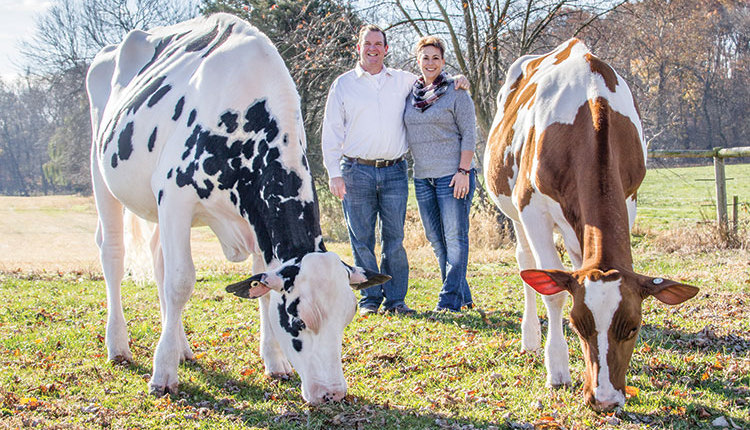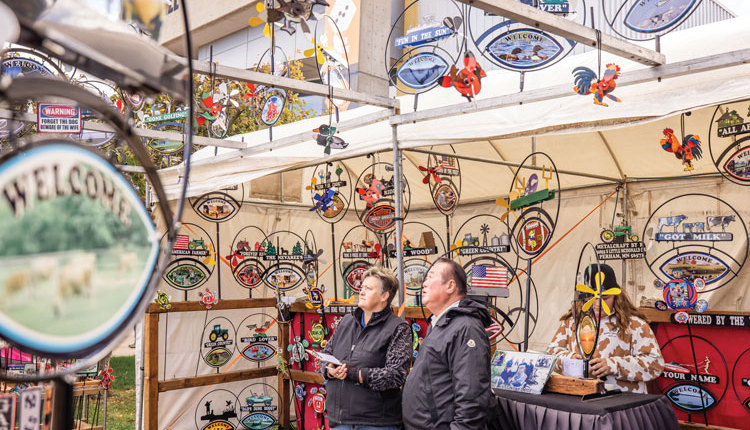
While the farm has always been home to a small tie stall Holstein, Jersey, and Red and White milking herd (65 total), it’s the Budjon Farm’s boarding business run by Tom and Kelli Cull and Tom’s father, John, of Lomira, Wis., that has truly flourished over the course of a decade. Calf and heifer services have grown tremendously under the hands-on ownership. In vitro fertilization (IVF) and traditional embryo transfer (ET) services are available for clients as well as bull housing, sale preparation, and cattle housing needs.
“It takes a strong team to be able to do what we do,” explained Kelli. “We have a full-time staff of eight at the farm on a ‘normal’ day, but show season needs more hands. We usually have a lot of family able to help, which sometimes pushes close to 30 people, but we have a paid crew of 17 employed.”
High expectations
As one would imagine, the larger the string, the higher the expectations. Kelli said, “We have three main goals within our string. First, we must be organized in every step we take. The tack and cattle trailers are packed in a manner of need, always trying to think ahead of what we would have to grab during our long trip, stops at farms when we are on the road, down to what is needed once we arrive at the showgrounds.”
Since the crew spends so much time together, pleasantries are a must. “Second rule, it’s important that everyone gets along,” shared Kelli. “It’s not only for the sanity of our staff, but also for the overall morale and professionalism for our clients. And the final rule, since we are always trying to represent our clients well, we like to take time to gather together for a recap on details that happened during each day so we can improve and grow.”
The farm’s inventory is usually kept around 500 head of cattle. Of those 500, approximately 350 individuals are at the farm for their estimated 50 clients, other than themselves and partners.
“I think our biggest challenge is to always maintain continuous trust throughout the working relationship with clients. A lot of our clients don’t live within driving distance of our farm, therefore, we need to provide peace of mind that we always have their best interest at heart,” shared Kelli. “I have always enjoyed the progression of events and cattle. I like to watch cows blossom into something great.”
You will notice, not every boarding facility is considered to have a “one size fits all” mentality. Most caregivers have the same goal in mind though, and that is to help their clients progress in the most beneficial way possible no matter the size of the string. This theory is true for the boarding and cattle services of Eaton Holsteins, Aaron and Caitlin Eaton in Marietta, N.Y. “We like knowing that every animal has reached its fullest potential and looked, placed the best they possibly could in the ring,” shared Aaron. “If we didn’t accomplish that, we learn what we can from the failures to become better and more prepared for the next show.”
Upon visiting the pack on show day, the crew of Eaton Holsteins could be seen busily prepping animals. “My wife, Caitlin, and I, along with one full-time person and some additional help from my father-in-law, usually take care of the work at home. Our show crew of about 10 to 12 people make things come together while we are exhibiting,” said Aaron. “We always try to do our best to care for each individual animal like they are our own.”
Fan favorites
Spectators come from all over just to grab a glimpse of the show greats and to check out the new competition, like a fan fest at a sports game. “It’s impressive at the number of spectators who come to Expo,” explained Aaron. “Some cattle have their own cheering section. After last fall, I’d say one of the most special animals we had in the string was Walnutlawn McCutchen Summer. It was encouraging to see the number of people who came to see this cow, especially the international spectators,” he continued. “It was great to be able to help her get into prime form.”
It’s certainly true that the ideal form has changed over time. “I think the show can only improve,” shared Aaron. “I think it’s amazing how much cattle have changed for the better over the past seven to eight years alone, whether it’s how extremely good the cows’ udders are now, or the straightness of lines and the balance and strength of the heifers. I hope we can all collectively as an industry continue to push this, whether you milk five or 5,000 cows. We can all respectfully appreciate the cattle winning major shows.”
Speaking of appreciation, all the caregivers have something in common, the ability to work among family and friends. “I don’t like to think that there is anything that makes us special or better than the next,” commented Aaron. “We really strive to focus on our ability to gain trusting individual relationships with our clients. Knowing that they believe in us to do our best with their animal(s) is half the goal.”
Eaton Holsteins is like other strings in that they, too, have a family-based approach with their business. “The way we care for the cattle never changes in the ‘downtime’ between show seasons,” assured Aaron. “The only difference is the daily washing becomes weather permitting in the winter months but still gets completed as much as possible.”

Most spectators get to see what happens at the show, but it takes a strong “home team” to be able to develop these animals into what you see in the ring. For Chris and Jennifer Hill, MD-Hillbrook Sales and Service in Thurmont, Md., the “home team” begins the developmental process.
“The animals get the same care as if it were show season,” explained Jennifer. “That is why it takes 365 days a year to develop a winner. During this time, Chris also travels to find the best opportunities for our clients/partners. Some of the best cattle are found during the off season and developed into the kind that have huge marketability.”
The crew at home helps prepare the caretakers for the long journey to Expo. “Someone goes ahead of the trailer and prepares the venue so the cattle can settle right in and do not have to wait once off the truck,” explained Jennifer. The preparation, with the same goal in mind as their barn neighbors, is always to assure clients the very best service.
“Having a winner is always the cherry on top but sometimes is not a true measure of success,” she said. “We think the trend that has presented itself over the past 10 years will continue to evolve. You will see more and more blended strings, both in breeds and ownership.
“A big part of this change is the cost savings that can be realized by combining herds. While great to see, it is not always cost efficient for most breeders to take ‘breeder strings’ to the shows. It makes more sense instead for them to select a few of the best and entrust their cattle to someone else,” Jennifer continued.
“There is also the case like we have with many of our partners, caring for cattle is not their forte, but they enjoy the industry and this allows them to be involved, which is a win for us both.”
The same theory proves true for Triple-T Holsteins, Nathan and Jenny Thomas, Nathan’s parents, John and Mary, along with his youngest brother, Andy Thomas, in North Lewisburg, Ohio.
“It seems that over the last 10 years there’s been fewer ‘breeder’ herd strings and more group strings. People are working together to go to the shows or paying someone to care for their animals,” expressed Jenny. “It’s expensive to take animals to a show like Expo. We try to be conservative in our spending, and it will still cost us around $20,000 to exhibit. The cost to enter, transport, bedding, feed, hay, labor force, food for the crew, hotels, and more, adds up quickly.”
Diligent 365 days a year
For some farms, show season is a surge in work and management. “Show season is hectic,” shared Jenny. “Long days and lots of work lead up to the show. Everything has got to be just right, and stress levels can become elevated because we can’t afford for an animal to get sick or injured during transport. In the off season, we may have a little breathing room, but it’s just time to look ahead for the next show season.”
Triple-T Holsteins begins choosing prospective animals during the off season. “Developing heifers from Day 1, calving in cows, you hear judges say, ‘it takes 365 days of the year,’ it is the truth,” expressed Jenny. “We have many goals, but the ultimate in showing is to win it all. However, there’s only one Grand Champion selected each year, and we must be realistic.”
If Grand Champion isn’t their only goal, the Thomas’ are certainly focused on developing top-end animals. “You must be able to look at your own string and evaluate them objectively. We know we don’t have a Grand Champion contender every year, we just try to set goals accordingly and prepare cattle to the best of our abilities.”
Triple-T Holsteins do not have any hired employees, but they board cattle for a handful of people, mostly friends and partners. “They know us and we know them,” said Nathan. “The workforce at our farm is the owners with a summer intern leading into fall. That said, we feel that it leaves less room for error to have a compact group work directly with the cattle.”
The Thomas’ focus at home is on developing their animals and those they have been entrusted with — particularly heifers. “We have not been around as long as some; we began milking cows 11 years ago. Before, we only had a handful of heifers at the farm, and now it’s close to 100 head. We generally milk anywhere from 25 to 30 cows and the rest are calves, heifers, and dry cows.”
Success is always a rewarding feeling for any string. “Obviously, when you win it is a great feeling and accomplishment. Seeing your cattle logo associated with offspring that do well is not only a goal, but a great feeling,” shared Jenny.
Next time, if you find yourself wandering the barns of World Dairy Expo, take an admirable look at the individuals who showcase those beautiful bovines for the world to see, not only just for them, but their clients as well.









